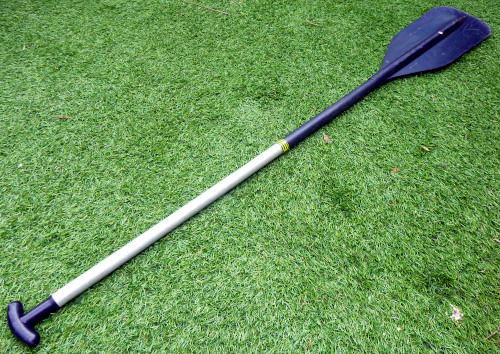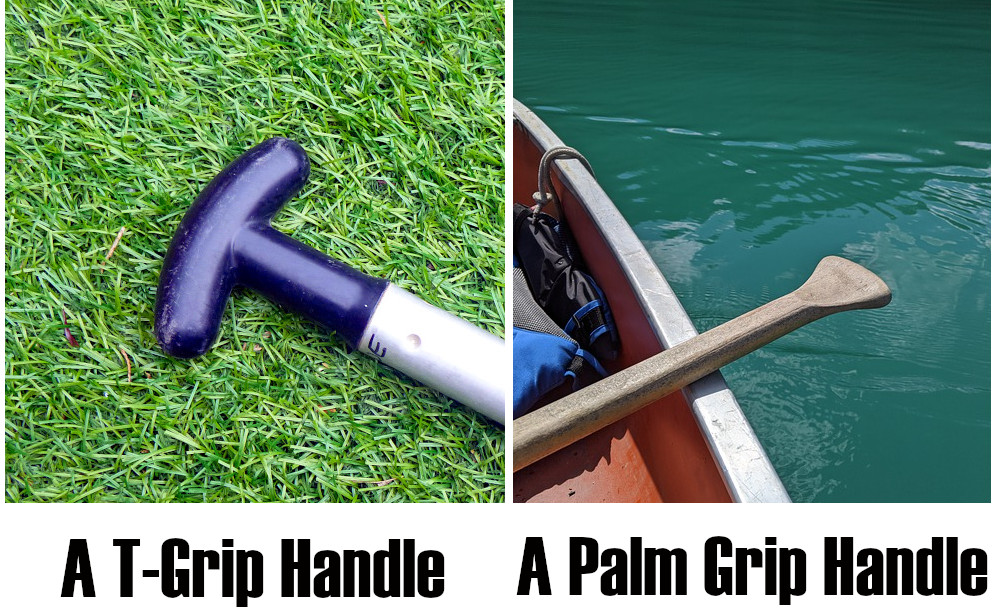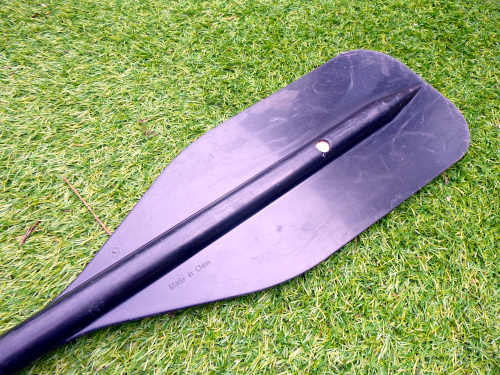Choosing A Canoe Paddle
Choosing the right canoe paddle makes a huge difference to your paddling ability and overall enjoyment.
Spending time to select your canoe paddle is well worth it and gives you pride in your paddle.
There are many canoe paddles available and selection can be tricky.
Read on to find out the key points your need to look for.
 A basic paddle with a plastic blade and T-grip handle and a aluminium shaft.
A basic paddle with a plastic blade and T-grip handle and a aluminium shaft.7 Key Points To Look Out For When Choosing A Canoe Paddle
1) Paddle length - The paddle length is measure from the top of the handle to the tip of the farthest point of the blade. This measurement is usually between 52 and 60 inches (132 to 152cm).
To find the best length for you, you should take your usual position in the canoe (kneeling or sitting) and put your arm horizontally out in front of you. It should extend away from your nose. The measurement from your fingers to the water line is the same as the measurement from the paddle handle to the joint between the shaft and the paddle blade (this is called the 'throat').
Adding on the length of the blade (usually 20 inches - but check for the paddle you are choosing) will give you the overall paddle length.
It sounds complicated, but it is straightforward to get the measurement.
Once you have a measurement as a guide, you should try some paddles of that length. Paddle with them and see how they feel. Remember to try your normal paddle strokes and canoe turns too.
The paddle length should enable you to gain leverage without having to overstretch your handle arm or take it too high off the horizontal.
Choosing a paddle that is up to a couple of inches either side of your actual measurement is fine if this feels better for you.

2) Handle Type - There are two main handle types - a T-grip and a palm grip. Both are perfectly fine for most canoe paddle types. A palm grip is more commonly found on wooden paddles.
How they feel to you when paddling will determine which one is better. A palm grip does allow slightly more pressure to push through the paddle from the palm of the hand.
3) Paddle Material - There are a variety of materials used to make paddles. A standard composite of plastic handle and blade with an aluminium shaft is very common. These provide a reasonably strong paddle for an average price.
Wooden paddles are sought after as your paddling improves. They provide a lighter weight and have a small amount of 'give' in the paddle. This feels better when paddling and puts less strain on your arms - especially on longer trips.
Wooden paddles generally cost more.
4) Durability - Depending on the type of paddling you do, you will need to consider the durability of the paddle. Wooden paddles are often less durable and will show marks and dents to the wood. Wear of the paddle blade, especially on the ends, is common.
Plastic will absorb small marks and dents and it won't affect the use of the paddle.
5) Straight/Bent Shaft - A straight shaft keeps the paddle blade in line with the shaft. This means you need to reach slightly further forward with your lead arm to ensure the blade pulls through the water vertically.
A bent shaft allows the blade to be vertical in the water whilst the shaft remains at an angle. This makes it easier to paddle and puts less strain on your back and arms.
Definitely try both types of shaft. You will quickly decide which one is best for you.
 A plastic paddle blade
A plastic paddle blade6) Blade Shape - The shape of the blade determines how much 'grab' the paddle has in the water. It's a balance between size and usability of the of the paddle. An enormous blade would be to difficult to use.
Again, try different shaped paddle blades. How they pull through the water and how much 'grab' they have will help you choose the right one for you.
7) Protecting Your Paddle -Often overlooked, but how you store your paddle will contribute to determining how long it will last.
After each use, clean and dry your paddle. Check for any obvious damage and replace/repair if necessary.
Store the paddle in a dry, dark place - a paddle bag perhaps.
Follow these points and you'll easily choose the right canoe paddle blade for your needs.
Have fun!
PS. Paddlesports can be dangerous.
Read our safety disclaimer - here

New paddling inspiration, tip, trip or technique video EVERY week! Watch Ed, Dave and Moo on their kayaking, canoe and SUP adventures. It's all about safely having fun on the water. 200,000+ views, 110+ videos & 900+ subscribers so far! Click below to start watching:
Ed & Dave Kayaking Youtube Channel
WANT TO HELP US?
We really value your visit to us today. We run this website and our Youtube channel to provide paddling inspiration, tips, trip and technique content to you. We love being out on the water! If you enjoyed your visit, you can support us by using the links below:
Buy us something on our wish list
Thank you
NEED WEB HOSTING?
We recommend IONOS. Great service, technical support and stable hosting. Click the link below to find out more:
IONOS Web Hosting - RECOMMENDED!



